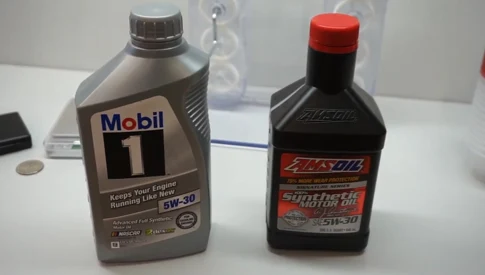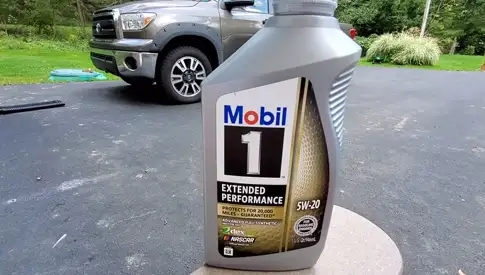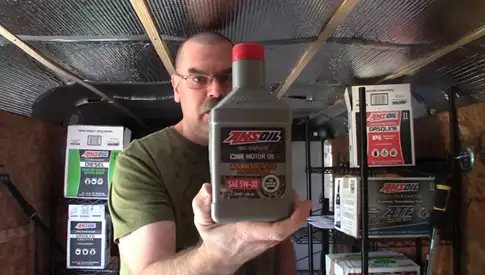Physical Address
304 North Cardinal St.
Dorchester Center, MA 02124
Physical Address
304 North Cardinal St.
Dorchester Center, MA 02124

Mobil 1 oil and Amsoil are two of the most well-known motor oils that keep your vehicle running smoothly. Both of these engine oils come with a range of benefits tailored to different driving conditions, engine types, and performance needs.
Despite their similarities, there are some significant differences between Mobil 1 and Amsoil.
One difference between Mobil 1 and Amsoil oil is their composition. While Amsoil uses a 100% synthetic base oil, Mobil 1 utilizes a blend of synthetic and mineral oils. In addition, they have different additives that make them unique.
Mobil 1 employs its proprietary SuperSyn additive system. Meanwhile, Amsoil incorporates a proprietary blend of additives that includes zinc and phosphorus.
We will explore the key differences between Mobil 1 and Amsoil in detail to help you determine which one is best suited for your vehicle’s engine.

Mobil 1 and Amsoil oils differ in several categories, including:
AMSOIL offers a diverse product range, with options like the Signature Series, Z-ROD, and OE, each designed to cater to particular types and applications of engines.
If you have a high-performance or classic engine, the Signature Series and Z-ROD are the way to go. These products offer superior protection to engines under extreme conditions, especially those with flat-tappet camshafts that are susceptible to high stress and wear.
Alternatively, if you have a modern vehicle with standard performance requirements, AMSOIL’s OE line is tailored to these engines.
AMSOIL also offers various gear oil products. Among these are the “Slip Lock” differential additive and gear oils tailored for specific applications such as marine gear lube, V-Twin primary fluid, and synthetic chaincase & gear oil for ATVs and snowmobiles.
Mobil 1, however, caters to a much broader range of vehicles and driving conditions with their product range.
Of course, they still offer options for high-performance engines, like the Extended Performance line, which is designed for engines that need high-performance oil.
The Advanced Fuel Economy line offers excellent fuel efficiency for modern vehicles looking to reduce their carbon footprint while still providing high-quality engine protection.
For older vehicles or those with higher mileage, Mobil 1’s High Mileage oil addresses the unique needs of engines with extended usage by including seal conditioners to prevent leaks.
If you prefer fewer oil changes, the Annual Protection line is the most convenient option. Also, Mobil 1 Racing is specially crafted for racing applications and meets the rigorous demands of high-performance racing engines.
Mobil 1 also provides gear lubricants that are engineered to protect and extend the life of transaxle, rear axle, and differential gears. These gear oils are available in variants such as 75W-90 and 75W-140 for different applications, ensuring optimal gear performance and longevity.
Both Mobil 1 and Amsoil’s gear oil are synthetic. When you compare synthetic and conventional gear oils, synthetic gear oils provide superior protection and performance.
AMSOIL uses a 100% synthetic base oil, resulting in a pure synthetic oil formulation. This means that the base oil is entirely derived from highly refined petroleum.
On the other hand, Mobil 1 is a blend of synthetic and mineral oils. Although it’s predominantly synthetic, it incorporates some mineral oil components into its formulation. This blend allows Mobil 1 to provide the benefits of synthetic oil while still utilizing some properties of mineral oil.
Both brands incorporate proprietary blends of additives to enhance the performance and protection of their synthetic motor oils.
Amsoil includes zinc and phosphorus additives, which are crucial for safeguarding high-performance and classic engines. These additives reduce wear and provide additional protection to critical engine components, especially in engines with flat-tappet camshafts.
In high-horsepower engines exposed to extreme heat and shearing forces, Amsoil also incorporates shear-stable viscosity improvers. Additionally, detergents and dispersants are used to keep the engine clean by preventing the buildup of deposits and sludge, while antioxidants slow down oil oxidation.
In contrast, Mobil 1 utilizes its proprietary SuperSyn additive system, which includes anti-wear additives to reduce friction and wear in critical engine components. Similar to Amsoil, Mobil 1 also includes detergents and dispersants to prevent sludge and deposit buildup, as well as antioxidants to inhibit oil oxidation.
Volatility refers to the tendency of oil to evaporate in extreme heat. AMSOIL has been found to resist volatility 38% better than Mobil 1. This means that AMSOIL is more effective at maintaining oil volume and performance in high-temperature environments compared to Mobil 1.
While Mobil 1 offers excellent overall performance, it may not be as resistant to volatility as AMSOIL. This can be a crucial consideration in extremely hot conditions where the oil’s ability to resist evaporation is vital for optimal engine protection.
Therefore, if you frequently operate your vehicle in high-temperature environments, using AMSOIL may provide better protection and longevity for your engine.

TBN measures the oil’s ability to neutralize acidic contaminants in the engine and maintain its alkaline reserve.
AMSOIL motor oils, such as the Signature Series, are known for their relatively high TBN. They provide 28% more acid-neutralizing power compared to Mobil 1.
On the other hand, Mobil 1 motor oils may have a lower TBN compared to AMSOIL. The specific TBN value for Mobil 1 oils may vary depending on the product line and viscosity grade.
Both oils meet or exceed API specifications, including SN, SM, SL, and more, ensuring excellent protection and performance. They also meet ILSAC GF-5 standards, making them suitable for modern, fuel-efficient engines.
However, one notable difference lies in their OEM approvals. Amsoil may have approvals from specific vehicle manufacturers such as GM, Ford, Chrysler, and others, indicating that their oils meet the requirements for use in those particular engines.
Meanwhile, Mobil 1 often holds approvals from leading vehicle manufacturers like GM and Ford, indicating that their oils are compatible with specific engines and meet manufacturer requirements. These OEM approvals provide additional assurance of quality and compatibility with specific vehicle engines.
| Category | AMSOIL | Mobil 1 |
| Product Range | Signature Series, Z-ROD, OE | Extended Performance, Advanced Fuel Economy, High Mileage, Annual Protection, Racing |
| Composition | 100% synthetic base oil | Blend of synthetic and mineral oils |
| Additives | Zinc, Phosphorus, shear-stable viscosity improvers | SuperSyn additive system, anti-wear additives |
| Volatility Resistance | 38% better than Mobil 1 | High overall performance, may have less resistance to volatility |
| Total Base Number (TBN) | 28% more acid-neutralizing power | TBN value may vary by product |
| Approvals | API, ILSAC, ACEA, OEM approvals | API, ILSAC, OEM approvals |

You can alternate between AMSOIL and Mobil 1 oils in your vehicle without any issues. Both brands offer high-quality synthetic motor oils that are compatible with most engines. It’s crucial to follow the manufacturer’s recommendations regarding oil viscosity and change intervals for your specific vehicle.
As long as you choose the appropriate viscosity and meet the requirements of your vehicle, you can confidently switch between these oils. Individual preferences, performance needs, and environmental factors may influence your choice between AMSOIL and Mobil 1, but from a compatibility perspective, switching is generally acceptable.
Always refer to your vehicle’s manual and consult with a professional if you have any doubts or specific concerns about switching between these oils.
To ensure optimal performance and protection for your engine, it’s generally not recommended to mix AMSOIL and Mobil 1 oils. While it’s technically possible to mix these two high-quality synthetic oils, doing so may dilute their performance characteristics and reduce their benefits.
It’s best to use one oil brand throughout an oil change cycle to maintain consistent and optimized engine protection. If you want to switch from one brand to the other, it’s advisable to perform an oil change to enjoy the specific advantages of each brand fully.
While compatibility isn’t a major concern, sticking to one brand during an oil change cycle is preferable to ensure you get the most out of your chosen oil.
When using AMSOIL Signature Series Synthetic Motor Oil, it’s recommended to have oil changes at intervals of up to 25,000 miles or 700 hours of operation or once a year, whichever comes first, under normal service conditions. In severe service conditions, the interval is advised to be 15,000 miles.
Conversely, if you choose Mobil 1 Extended Performance synthetic oil, it’s suggested to change your oil every 20,000 miles or once a year, whichever happens first.
It’s important to consider your specific driving conditions and maintenance preferences when deciding between these two oils.

The differences between Mobil 1 oil and AMSOIL oil offer you a choice tailored to your specific needs. Mobil 1 provides a wide range of options to cater to various vehicles and driving conditions.
AMSOIL, on the other hand, stands out with its 100% synthetic base oil and robust additive package, making it particularly suitable for high-performance and classic engines.
These differences in product range, composition, additives, and price allow you to choose the oil that best suits your vehicle.
Whether you prioritize versatility, high-performance protection, or affordability, both brands offer quality options. So, select the one that aligns with your engine’s demands and enjoy optimal performance and protection.
Last update on 2026-01-05 / Affiliate links / Images from Amazon Product Advertising API